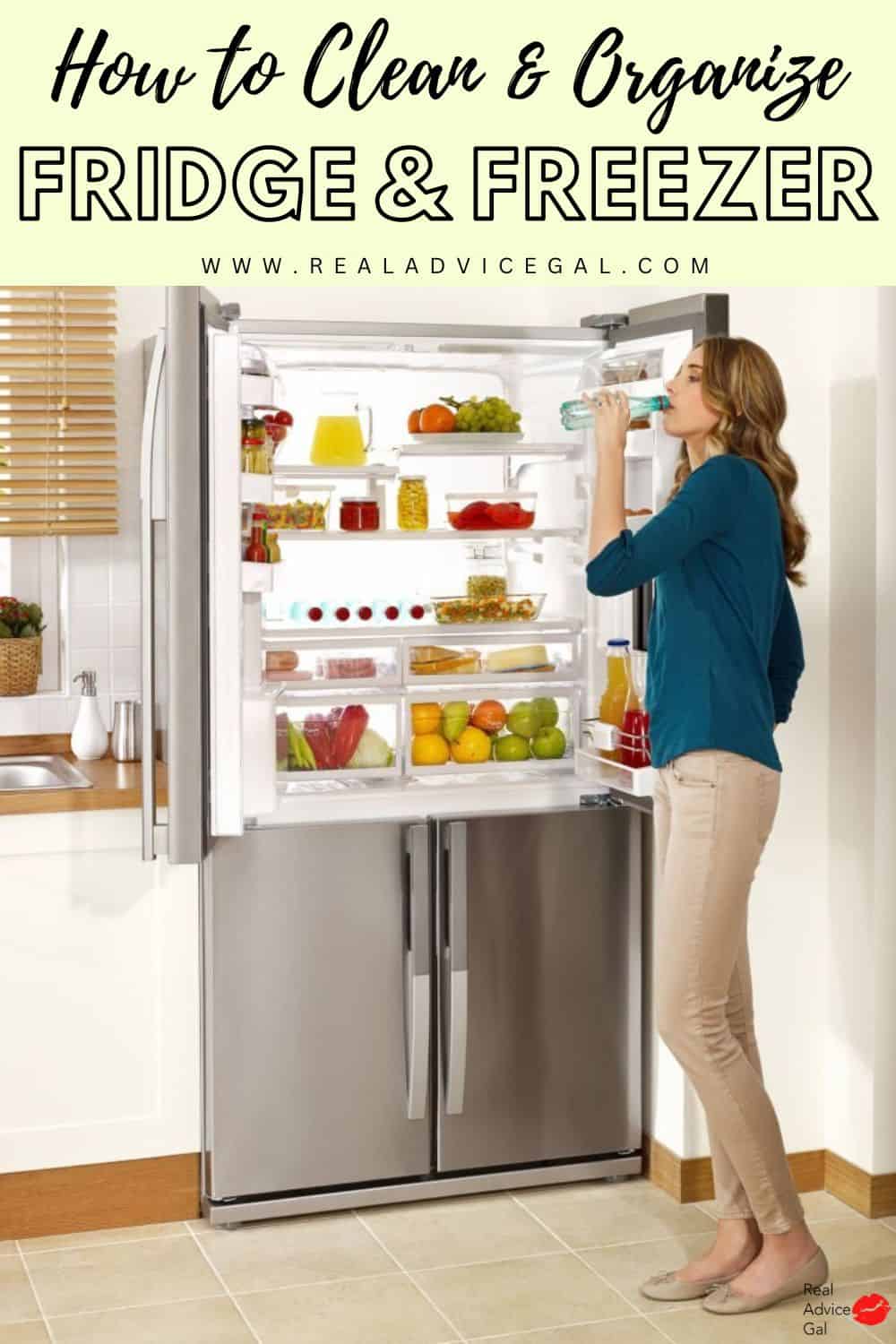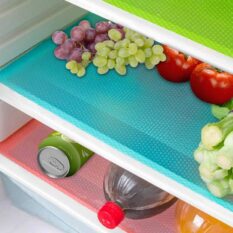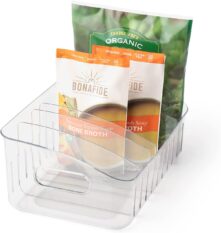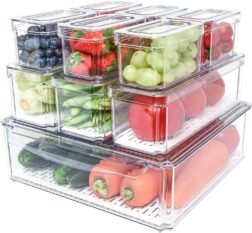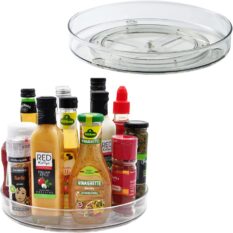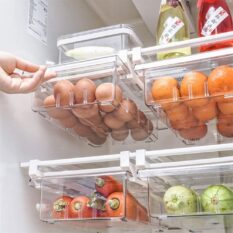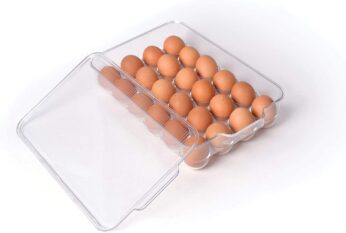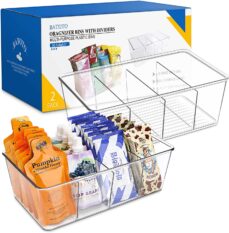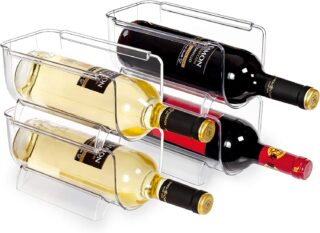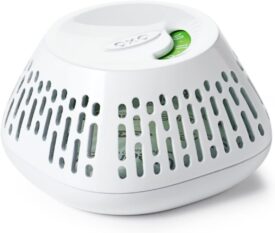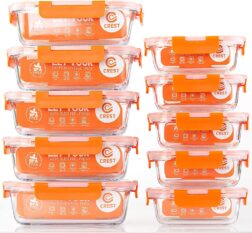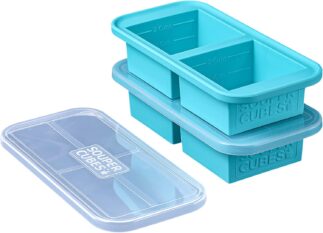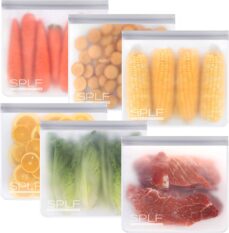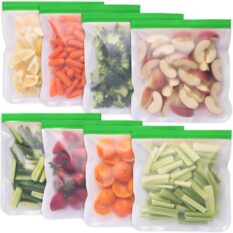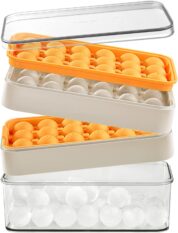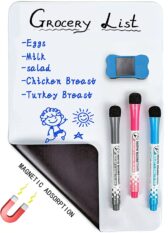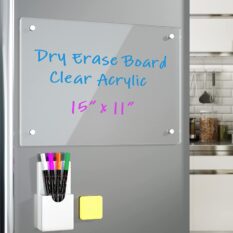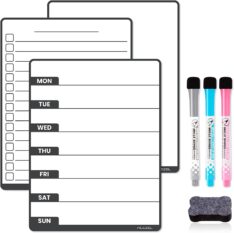Spring Cleaning the Fridge and Freezer – How to Clean the Refrigerator
Your home deserves a deep clean and organization during springtime, and your refrigerator is no exception. Read on for my tips on spring cleaning, how to clean the refrigerator and the freezer, and some organizing tips.

After a prolonged winter of storing holiday leftovers, your fridge might need some serious attention.
It’s easy for your fridge to become dirty and cluttered over time, leading to unpleasant smells, bacteria growth, and even food contamination. That’s why it’s important to regularly clean the refrigerator thoroughly
Spring cleaning your fridge will not only clean it but also increase the lifespan of your food and keep your loved ones healthy by minimizing the risk of foodborne illnesses.
Below are tips to help you give your refrigerator a thorough spring cleaning.
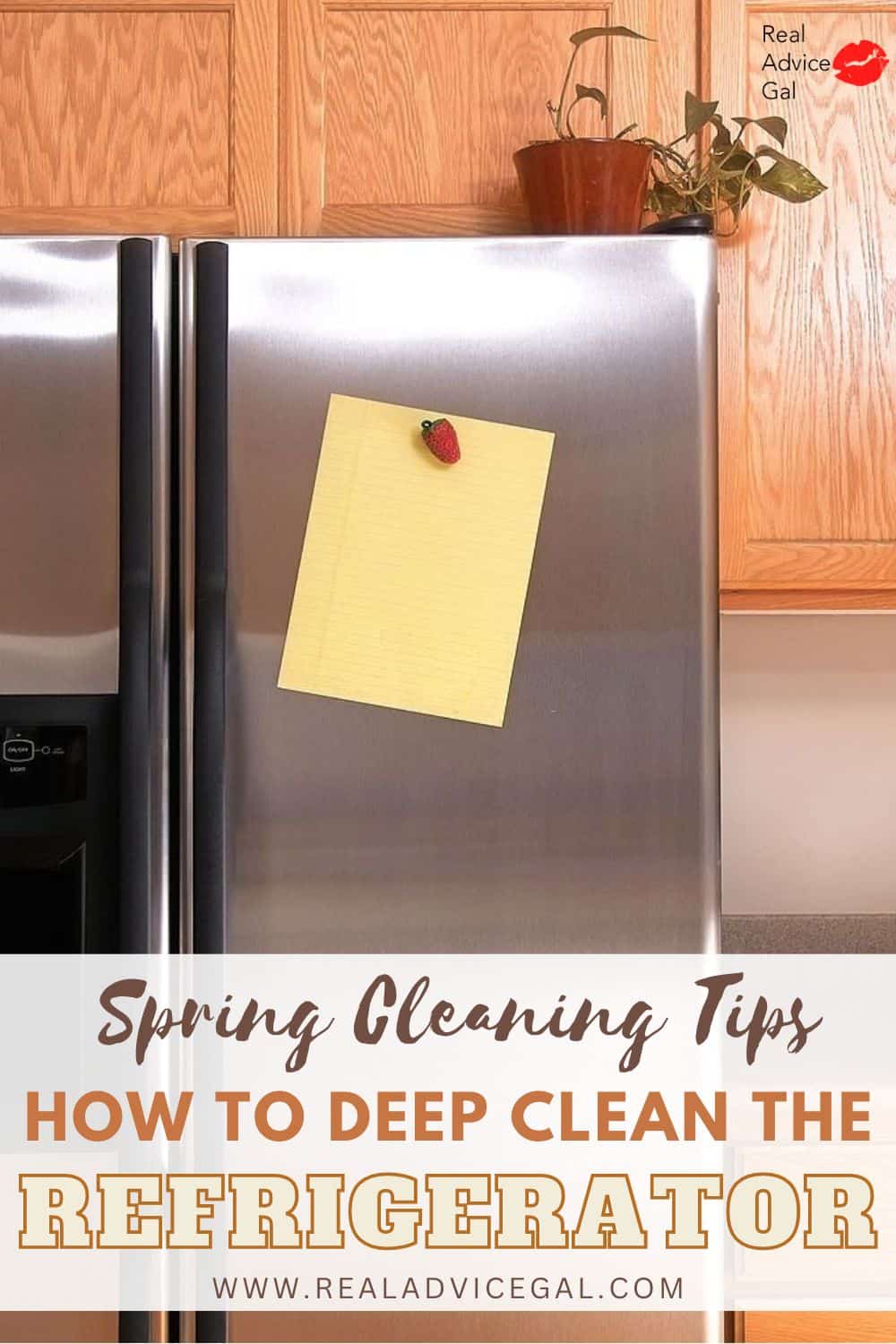
How to Clean the Refrigerator
Follow these simple steps to deep clean the refrigerator.
STEP 1: Empty the fridge
Start the task by removing everything from your refrigerator.
This will make it easier for you to access all the nooks and crannies of your fridge, and ensure that you don’t miss any spots during the cleaning process.
Now sort through your food and check expiration dates.
Wipe off any sticky or messy spills.
STEP 2: Discard Expired Food
Immediately discard any expired or spoiled food items.
Check the labels and expiration dates of each item, and throw away anything that’s no longer safe to eat.
STEP 3: Remove shelves and drawers
Once your fridge is empty, take out the shelves and drawers.
You can clean them in the sink using warm, soapy water or a dishwasher.
Allow them to air dry while you tidy up the rest of your fridge.
STEP 4: Clean the interior
Using a solution of equal parts water and vinegar or mild detergent, clean the inside of your fridge with a clean cloth.
Ensure you clean the surrounding areas, and any compartments or drawers that can’t be removed.
STEP 5: Clean the exterior
Don’t neglect the outside of your refrigerator, including the top and sides.
Use a damp cloth or sponge and mild cleaner to wipe down the surfaces.
For stainless steel fridges, utilize a cleaner made specifically for stainless steel to prevent damaging the finish.
STEP 6: Clean the Door Gasket
The door gasket is the rubber seal around the edge of your fridge door that keeps the cold air inside.
It’s important to clean this regularly to prevent bacteria growth and ensure that your fridge is working efficiently.
Use a solution of warm water and vinegar to wipe down the door gasket, making sure to get into all the folds and crevices.
STEP 7: Organize your food
Since your fridge is now clean, organize your food.
Group similar items together, such as dairy products, fruits, and vegetables.
Consider using storage containers to keep items like condiments and sauces organized. Label any items you transfer to containers with the name and date.
STEP 8: Set the temperature
Set your refrigerator to the appropriate temperature to keep your food fresh as long as possible.
The optimal temperatures for your refrigerator is below 40°F and freezer 0°F, as advised by the U.S. Food and Drug Administration (FDA). It is recommended to adhere to these temperature guidelines for safe food storage.
But the ideal temperature for your fridge is between 35°F and 38°F.
To keep your fridge clean and organized all year round, make it a habit to clean up spills as soon as they occur. Check the expiration dates of your food regularly and discard any expired items. make sure to clean the refrigerator every season or at least twice a year.

For more ideas on how to clean the refrigerator, check out Natural Refrigerator Cleaning Tips
How to Organize Refrigerator
After you clean the refrigerator, it’s time to organize.
If you have a tendency to shove your food into any available space in your refrigerator, it’s time to change your ways.
A well-organized fridge will help you minimize waste by allowing you to quickly see and find everything you need.
Certain areas inside your refrigerator may differ in temperature from others, leading to warmer or colder spots.
However, here’s what you need to know: Typically, the top shelf and door sections tend to be the warmest regions, while the middle and bottom shelves tend to be progressively cooler.
Top Shelf
The top shelf is one of the warmer areas in your fridge, so avoid storing any fresh meat here.
Instead, consider utilizing it for leftovers and takeout food—items that you need to consume soon.
Since this shelf is usually the first one you see when you open the door, it’s an ideal spot to keep the food you frequently reach for.
Middle Shelf
Consider using the middle shelf to store eggs, dairy products or produce that can be left uncovered, such as berries.
Yes, eggs, milk and other dairy SHOULD NOT be placed in the door eventhough your refrigerator has built-in egg organizer in the door section.
You also typically have the most vertical space on this shelf, so it’s an excellent place to store taller containers.
Bottom Shelf
Designate the bottom shelf for meat or fish.
This is not only the coolest section of your fridge, reducing the risk of spoilage, but also helps prevent accidental leakage that can cause unpleasant odors and contamination to other foods.
Drawers
It’s simple – place all of your produce in the crisper drawers for optimal freshness.
You’re likely aware that it’s essential to separate your fruits and vegetables. This is particularly important because most fruits emit a gas that can accelerate the decomposition of vegetables.
Door
It’s advisable to store condiments in the door. Anything high in salt or sugar should be in the door section.
By organizing your food items in their respective places, you can help extend their shelf life and prevent overspending during grocery shopping.
A clean and organized fridge not only looks better but can also increase the lifespan of your food and keep your family healthy. So, get ready to give your fridge a good spring cleaning!
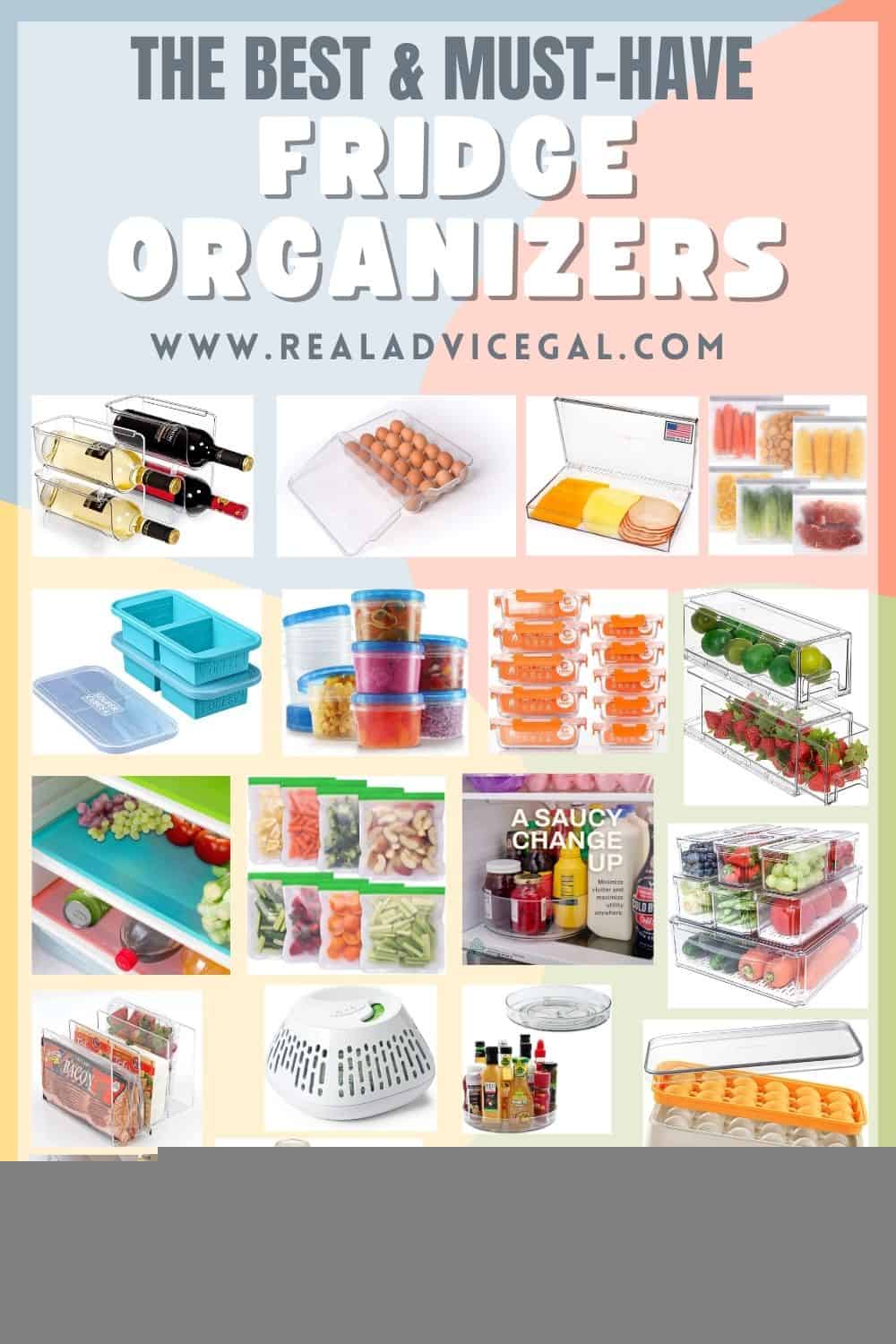
BEST REFRIGERATOR ORGANIZER
Now that you clean the refrigerator, you may be interested in elevating your organizational game. Below are some of the best refrigerator organizers.
It’s best that you measure the depth, width, and height of the entire interior of your fridge, as well as the size of the tallest and widest items you intend to store, so you’ll get the best refrigerator organizers that will fit your fridge and freezer.
Refrigerator Liners Mats Washable
- Trust me these are must-haves for your fridge! It protects your shelves from drips and spills. Just remove, wash and reuse. So, when there’s a spill you just wash the liner and you don’t have to pull out the shelves or clean the whole fridge.
- Non-slip and can be trimmed to your desired size.
Soda Can Organizer for Refrigerator
- Save space in your refrigerator by organizing those soda cans
- It’s transparent so you can easily see everything.
- Cans roll forward to dispense
- Holds up 12 soda cans
FreezeUp Freezer Bin 12″, Fridge Organizer with Storage
- This clear bin makes frozen food easy to find
- It includes four dividers that can be adjusted to fit frozen items of any size while keeping everything (including loose bags) nice and tidy.
Pomeat 10 Pack Fridge Organizer, Stackable Refrigerator Organizer Bins with Lids
- BPA-free clear containers for food storage
- Designed with a tray and dripping hole at the bottom. To elevate produce away from moisture and keep food fresh & extend the shelf life.
Lazy Susan Rotating Turntable Organizer
- This 360° rotating lazy susan organizer tray makes items easy to reach
- Use it in the fridge to organize bottles, baby food jar, snacks etc.
Home Intuition Round Plastic Lazy Susan Turntable Food Storage Container
- 100% BPA, Phthalate, Chlorine and PVC free
- Perfect for storing items like jars, spices, condiments, and more
Fridge Drawer Organizer, Refrigerator Organizer Bins, Pull Out with Handle
- Add extra drawers to your fridge
- Perfect for organizing condiments, vegetables, meats, deli, cheeses, snack, bagged frozen vegetables and other food items in the fridge
- Take note: make sure to read the specification and size requirements for this drawers to fit in your refrigerator.
Egg Holder for Refrigerator with Lids and Handles
- It provides good ventilation at the same time keeping the smell of eggs from affecting other food inside the fridge.
- I like this because aside from keeping eggs fresh longer, in case eggs break it will just spill in this container and not in your fridge shelf.
Pantry Organization and Storage Bins, Fridge Organizer Bins
- Plastic storage bins.Each Dimension: 9.7x 5.2x 3.5Inch.
- There are 3 removable dividers in each plastic storage bins, easy to separate and organize items.
Refrigerator Wine and Water Bottle Holder
- If you keep wine in your fridge this is a must have.
- You can stack these bottle holders vertically or place side by side.
Sorbus Fridge Drawers – Clear Stackable Pull Out Refrigerator Organizer Bins
- Stackable fridge organizer drawers
smartified Fridge Acrylic Organizer with Vertical Dividers
- Ideal for storing flat items in the fridge such as: fruit clamshells, deli packages (bacon, sausages, ham, salami, cheese, pre-cooked meals), raw meat trays, flat frozen ziplock, etc.
- This keeps out moisture and seals in freshness to extend the life of your meat or cheese
- Slim design so it doesn’t take much space
OXO Good Grips GreenSaver Standing Crisper Drawer Insert
- 360° hole pattern provides proper air circulation from all sides
- Enhanced carbon filter absorbs ethylene gas to keep produce fresh longer
Tafura Twist Top Soup Storage Containers with Lids
- 16 Oz premium leakproof soup containers with screw-on plastic sealed lids
- You can also use these for pre-cut fruits or veggies
- Perfect for food prepping. These glass containers are perfect for freezer and when you’re going to eat just put them directly in your oven or microwave
- Made from high quality borosilicate glass, which are oven safe over to 700?
Souper Cubes 2-Cup Extra-Large Silicone Freezer Tray with lid
- Perfect for meal prep and freezing soups. Can store 2 cup / 500 mL
- 100% FDA Food Grade Silicone: BPA Free – Dishwasher Safe – Oven Safe
SPLF BPA FREE Reusable Storage Bags, 6 Pack
- Food-grade reusable storage bags. Made of food-grade PEVA material that is PVC, BPA, Chloride and Lead free
- Double closures making it airtight leakproof
Greenzla Reusable Gallon Bags – 8 Pack
- Extra-thick reusable bags
- 100% leak-proof, and well sealed.
- BPA-Free Made from high quality food-grade PEVA material
- Perfect for storing and freezing meat, chicken and fish
longzon Round Ice cube Trays for Freezer,Easy-Release Silicone
- 100% BPA Free,Made of Silicone and PP material
- Just twist the ice cube tray and it’s quick to release. Turn the tray upside down to get those perfectly round ice cubes!
- Has lid and stackable
If you’re interested in elevating your organizational game, you may want to consider installing a dry-erase sheet on your fridge.
This allows you to maintain an up-to-date inventory of what’s in your fridge without having to rummage through it. You can write down the fresh produce you purchased this week or which meat items are approaching their expiration dates.
By doing so, you can quickly identify which ingredients you’re lacking and keep track of expiration dates.
Magnetic Calendar for Fridge with Markers
Whiteboard Magnetic Dry Erase Board
Acrylic Note Board Refrigerator Dry Erase Board Magnetic
Weekly Dry Erase Board for Fridge
How to Clean the Freezer
Cleaning your freezer is important to make sure it’s working well and keeping your food safe. Here are some steps to follow:
- Turn off and unplug the freezer, and take out everything inside, like shelves and ice trays.
- If there’s ice built up, defrost the freezer. You can let it sit for a few hours or use a hairdryer to speed things up. Make sure to put towels or a container under the freezer to catch any water.
- Use a soft-bristled brush or scraper to remove any debris or loose ice, being careful not to damage the inside of the freezer.
- Mix equal parts water and vinegar in a spray bottle and spray the interior of the freezer, including walls, shelves, and drawers. Use a clean cloth or sponge to wipe everything down. If you have stubborn stains, use a baking soda and water solution or a specialized freezer cleaner.
- Dry the inside of the freezer with a clean towel to prevent ice buildup.
- Once it’s dry, put any shelves or drawers back in. If necessary, wait a few hours before putting food back in.
- Use a damp cloth with mild detergent to clean the outside of the freezer, including buttons, handles, and displays.
Spring Cleaning Tips with Free Printable Deep House Cleaning Checklist
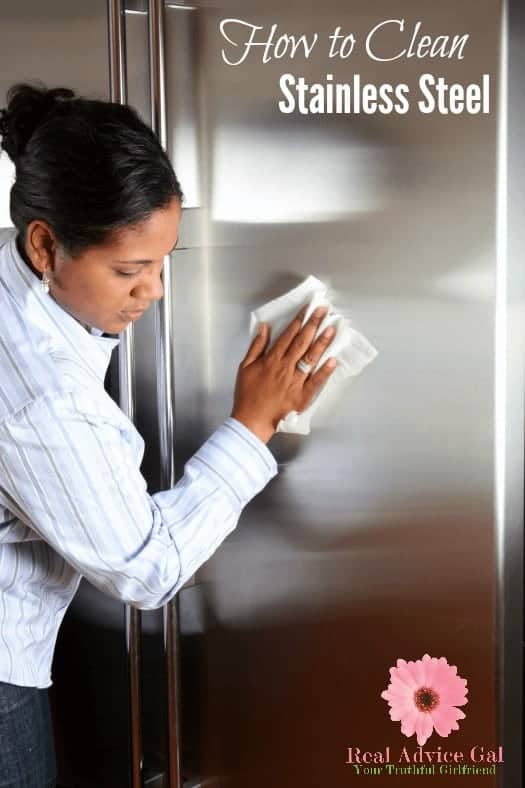
Disclosure: “As an Amazon Associate I earn from qualifying purchases.”
Meet Net, a skincare enthusiast and creative writer! With a passion for all things skincare, she is always eager to explore and learn about the latest trends and innovations in the industry. When not writing or indulging in their skincare routine, Net enjoys binge-watching TV series, knitting, and trading, among other hobbies. She is always eager to take on new challenges and try new things. Get ready to be inspired and learn something new with Net!






